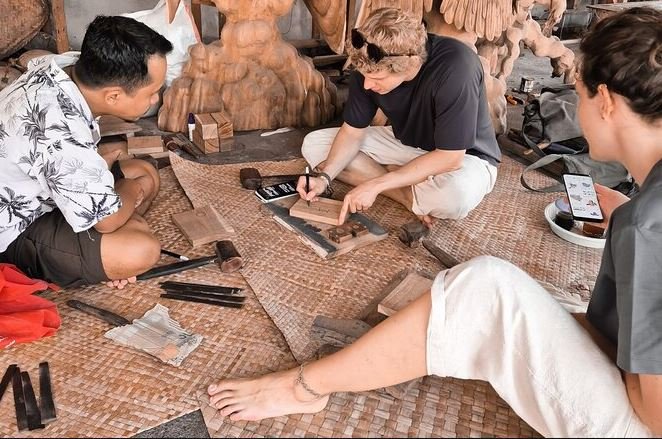Balinese woodcarving is more than just an art form; it is a profound expression of Bali’s cultural heritage, spirituality, and craftsmanship. Rooted in centuries-old traditions, this intricate craft has been passed down through generations, with each piece telling a story of mythology, religion, and daily life. For those eager to delve into this art, Bali offers numerous opportunities to learn from master artisans in authentic settings.
Understanding Balinese Woodcarving
Balinese woodcarving is characterized by its detailed reliefs, often depicting scenes from Hindu mythology, nature, and traditional life. The process involves meticulous handwork, using tools like chisels and mallets to transform raw wood into intricate masterpieces. Common woods used include suar, jackfruit, and hibiscus, each chosen for its texture, grain, and durability.(afar.com)
Top Places to Learn Balinese Woodcarving
1. Mas Village, Ubud
Mas Village, located just south of Ubud, is renowned as the heart of Balinese woodcarving. The village is home to numerous workshops and galleries where visitors can observe artisans at work and even try their hand at carving. Notable establishments include:
- Pak Wayan’s Workshop: A 2-hour introductory class where participants learn basic carving techniques under the guidance of a seasoned artisan. The session includes all materials and tools, and students can take home their creations.
- Njana Tilem Gallery: This gallery showcases exquisite wood carvings and offers workshops for those interested in learning the craft. Visitors can engage with artists and gain insights into traditional techniques.
2. Usada Bali, Ubud
Usada Bali offers an immersive experience into the world of Balinese woodcarving. Under the guidance of Nyoman, a fourth-generation master carver, participants can
- Tour the artist’s gallery and museum, featuring mythological sculptures and traditional furniture.
- Engage in hands-on carving sessions, creating their own wooden reliefs.
- Enjoy a picnic and discussion, learning about the history and philosophy behind the art form.
3. Keliki Village, Near Ubud
Keliki Village is a hidden gem known for its traditional Balinese art forms, including wood carving. Wayan Suardana, a local artist, offers workshops where visitors can:
- Learn carving techniques in a traditional Balinese setting.
- Experience authentic Balinese architecture and culture.
- Support the community through art and educational initiatives.
4. Balinese Home Workshops
Several local artisans open their homes to visitors, providing intimate and personalized carving experiences. These workshops often include:
- One-on-one instruction in a home setting.
- Opportunities to learn about the cultural significance of the carvings.
- Visits to nearby attractions, such as the Tegallalang Rice Terrace.
What to Expect in a Woodcarving Workshop
A typical Balinese woodcarving workshop includes:
- Introduction to Tools and Materials: Learn about the different types of wood and carving tools used in the craft.
- Basic Techniques: Understand fundamental carving methods, including sketching designs and using chisels and mallets.
- Hands-on Practice: Create your own carving, guided by an experienced artisan.
- Cultural Insights: Gain knowledge about the symbolism and stories behind traditional Balinese carvings.
- Souvenir: Take home your handcrafted piece as a memento of your experience.
Tips for Aspiring Woodcarvers
- Start with Simple Designs: Begin with basic patterns and gradually progress to more complex designs.
- Practice Regularly: Consistent practice helps improve technique and precision.
- Learn About the Culture: Understanding the cultural context enhances the carving experience and appreciation.
- Be Patient: Woodcarving requires time and patience; don’t rush the process.
Conclusion
Learning traditional Balinese woodcarving offers a unique opportunity to connect with Bali’s rich cultural heritage. Whether you’re a seasoned artist or a curious beginner, the island’s workshops provide a welcoming environment to explore this intricate art form. By engaging with local artisans and immersing yourself in the process, you not only acquire a new skill but also contribute to the preservation of Bali’s artistic traditions









